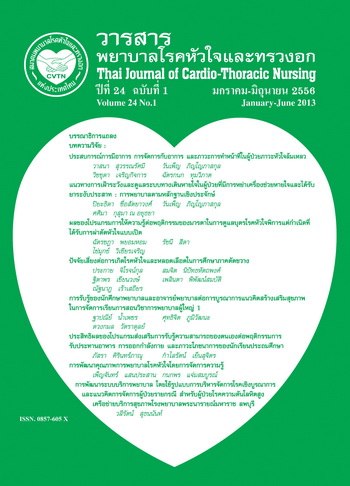แนวทางการเฝ้าระวังและดูแลระบบทางเดินหายใจในผู้ป่วยที่มีการหย่าเครื่องช่วยหายใจ และได้รับยาระงับประสาท การพยาบาลตามหลักฐานเชิงประจักษ์
Keywords:
การเฝ้าระวังและดูแลระบบทางเดินหายใจ, การหย่าเครื่องช่วยหายใจ, ยาระงับประสาท, การพยาบาลตามหลักฐานเชิงประจักษ์, Respiratory Monitoring and Care, Weaning from Mechanical Ventilation, Sedatives, Evidence-Based Nursing PracticeAbstract
การศึกษาครั้งนี้ มีวัตถุประสงค์เพื่อวิเคราะห์และสังเคราะห์เนื้อหาจากหลักฐานเชิงประจักษ์เกี่ยวกับการ เฝ้าระวังและดูแลระบบทางเดินหายใจ ในผู้ป่วยที่มีการหย่าเครื่องช่วยหายใจและได้รับยาระงับประสาท สืบค้นจากหลักฐานเชิงประจักษ์ที่ตีพิมพ์ระหว่างปี ค.ศ. 2002-2012 ผลการศึกษาพบว่า งานวิจัยที่เกี่ยวข้องมีจำนวน 15 เรื่อง ครอบคลุมการเฝ้าระวังและดูแลในระยะก่อนหย่าเครื่องช่วยหายใจ ระยะการหย่าเครื่องช่วยหายใจ และระยะหลังการหย่าเครื่องช่วยหายใจ ประกอบด้วยการประเมินทางเดินหายใจ การหายใจ การไหลเวียนโลหิต ระดับ ความรู้สึกตัว และปัจจัยที่มีผลต่อการหย่าเครื่องช่วยหายใจ รวมทั้งการดูแลประสิทธิภาพของทางเดินหายใจและ การดูแลด้านจิตสังคม
การศึกษานี้เป็นประโยชน์ต่อการพัฒนาแนวทางการเฝ้าระวังและดูแลระบบทางเดินหายใจ ในผู้ป่วยที่มีการหย่าเครื่องช่วยหายใจและได้รับยาระงับประสาท เพื่อส่งเสริมการดูแล การประสานงาน การตัดสิน ใจการรักษาพยาบาลร่วมกันระหว่างพยาบาลและทีมสหสาขาวิชาชีพ โดยควรมีการเผยแพร่ความรู้ที่ได้จากหลัก ฐานเชิงประจักษ์ และนำประเด็นที่ได้ไปศึกษาวิจัยในบริบทของแต่ละหน่วยงานต่อไป
Respiratory Monitoring and Care in Patients Undergoing Weaning from Mechanical Ventilation and Receiving Sedatives: Evidence-Based Nursing Practice
The objective of this study was to analyze and synthesize knowledge on evidence-based practices of respiratory monitoring and care in patients undergoing weaning from mechanical ventilation and receiving sedatives. Related literature was searched through evidence-based practice documents published between 2002 to 2012. The results revealed 15 related research papers which covered respiratory monitoring and care during pre-weaning phase, weaning-phase, and post–weaning phase. In each phase, the respiratory monitoring and care process includes assessment of airway, breathing, circulation, level of consciousness, and weaning ventilator factors, along with the provision of effective respiratory care and psychosocial support. The findings of this study are useful for the further development of respiratory monitoring and care in patients undergoing weaning from mechanical ventilation and receiving sedatives in order to promote best care, collaboration, and effective decision making between nurses and multidisciplinary teams.
There should be dissemination of knowledge from these evidence-based practices to health care organizations, whereas further research should be conducted about weaning issues in individual settings.
Downloads
How to Cite
Issue
Section
License
บทความนี้ยังไม่เคยตีพิมพ์หรืออยู่ในระหว่างส่งไปตีพิมพ์ในวารสารอื่น ๆ มาก่อน และกองบรรณาธิการขอสงวนสิทธิ์ในการตรวจทาน และแก้ไขต้นฉบับตามเกณฑ์ของวารสาร ในกรณีที่เรื่องของท่านได้ได้รับการตีพิมพ์ในวารสารฉบับนี้ถือว่าเป็น ลิขสิทธิ์ของวารสารพยาบาลโรคหัวใจและทรวงอก






